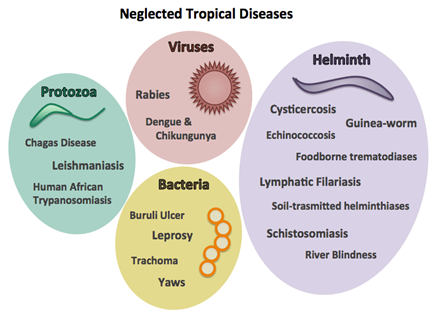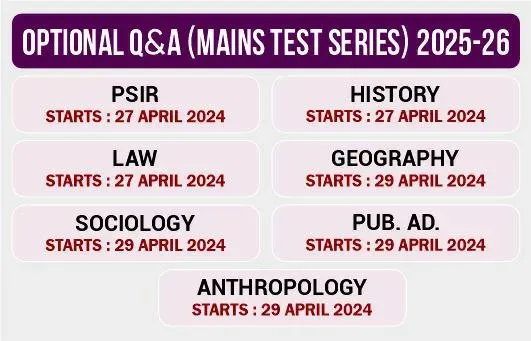NEGLECTED TROPICAL DISEASE
- Published
21st Feb, 2020 -
 Download PDF
Download PDF
Context:
The first-ever edition of "World Neglected Tropical Diseases Day"(World NTD Day) is launched on 30 January 2020. This initiative brings together various civil society organisations, community leaders, global health experts and policymakers working in the field of NTDs.
They share a bold ambition: #BeatNTDs. For good. For all, a goal fully supported by the Institute of Tropical Medicine (ITM) in Antwerp.
- Neglected tropical diseases(NTDs) are a diverse group of communicable diseases that prevail in tropical and subtropical conditions in 149 countries.
- NTDs are a diverse set of bacterial, viral, and parasitic pathogens that collectively cause significant illness and debilitation, primarily in impoverished communities of low and middle-income countries.
- Neglected tropical diseases (NTDs) are called "neglected," because they generally afflict the world's poor and historically have not received as much attention as other diseases.
- These diseases affect more than one billion people and cost developing economies billions of dollars every year.
- Populations living in poverty, without adequate sanitation and in close contact with infectious vectors and domestic animals and livestock are those worst affected.
- Effective control can be achieved when selected public health approachesare combined and delivered locally.
- Interventions are guided by the local epidemiology and the availability of appropriate measures to detect, prevent and control diseases.
- Implementation of appropriate measures with high coverage will contribute to achieving the targets of the World Health Organization (WHO) NTD Roadmapon neglected tropical diseases, resulting in the elimination of many and the eradication of at least two by 2020.
- In May 2013, the 66th World Health Assembly resolved to intensify and integrate measures against neglected tropical diseases and to plan investments to improve the health and social well-being of affected populations.
- WHO is working with the Member States to ensure the implementation of resolution 12.
- In 2016, the 69th Assembly adopted resolution 21 on addressing the burden of mycetoma and requested WHO, through the Strategic and Technical Advisory for Neglected Tropical Diseases, “to define a systematic, technically-driven process for evaluation and potential inclusion of additional diseases among the ‘neglected tropical diseases’”.
- Accordingly, in 2017 the 10th meeting of the Strategic and Technical Advisory Group for Neglected Tropical Diseases received proposals for the addition of diseases and, pursuant to the required procedures, chromoblastomycosis and other deep mycoses, scabies and other ectoparasites and snakebite envenoming have been added to the NTD portfolio.
- Dengue: A mosquito-borne infection causing a flu-like illness that may develop into severe dengue and cause lethal complications.
- Rabies: A preventable viral disease transmitted to humans through the bites of infected dogs, that is invariably fatal once symptoms develop.
- Trachoma: A chlamydial infection transmitted through direct contact with the infectious eye or nasal discharge, or through indirect contact with unsafe living conditions and hygiene practices, which left untreated causes irreversible corneal opacities and blindness.
- Buruli ulcer: A debilitating mycobacterial skin infection causing severe destruction of the skin, bone and soft tissue.
- Yaws: A chronic bacterial infection affecting mainly the skin and bone.
- Leprosy: A complex disease caused by infection mainly of the skin, peripheral nerves, mucosa of the upper respiratory tract and eyes.
- Chagas disease: A life-threatening illness transmitted to humans through contact with vector insects (triatomine bugs), ingestion of contaminated food, infected blood transfusions, congenital transmission, organ transplantation or laboratory accidents.

- Human African trypanosomiasis (sleeping sickness): A parasitic infection spread by the bites of tsetse flies that is almost 100% fatal without prompt diagnosis and treatment to prevent the parasites invading the central nervous system.
- Leishmaniases: Disease transmitted through the bites of infected female sandflies that in its most severe (visceral) form attacks the internal organs and in its most prevalent (cutaneous) form causes face ulcers, disfiguring scars and disability.
- Taeniasis and neurocysticercosis: An infection caused by adult tapeworms in human intestines; cysticercosis results when humans ingest tapeworm eggs that develop as larvae in tissues.
- Dracunculiasis (guinea-worm disease): A nematode infection transmitted exclusively by drinking-water contaminated with parasite-infected water fleas.
- Echinococcosis: Infection caused by the larval stages of tapeworms forming pathogenic cysts in humans and transmitted when ingesting eggs most commonly shed in faeces of dogs and wild animals.
- Foodborne trematodiases: Infection acquired by consuming fish, vegetables and crustaceans contaminated with larval parasites.
- Lymphatic filariasis: Infection transmitted by mosquitoes causing abnormal enlargement of limbs and genitals from adult worms inhabiting and reproducing in the lymphatic system.
- Onchocerciasis (river blindness): Infection transmitted by the bite of infected blackflies causing severe itching and eye lesions as the adult worm produces larvae and leading to visual impairment and permanent blindness.
- Schistosomiasis: Trematode infections transmitted when larval forms released by freshwater snails penetrate human skin during contact with infested water.
- Soil-transmitted helminthiases: Nematode infections transmitted through soil contaminated by human faeces causing anaemia, vitamin A deficiency, stunted growth, malnutrition, intestinal obstruction and impaired development.
- Mycetomais a chronic, progressively destructive inflammatory skin disease which usually affects the lower limbs. Infection is thought to be caused by the inoculation, through a thorn prick or skin damage, of fungi or bacteria into the subcutaneous tissue.
- Across health and development, world awareness days offer an annual opportunity to mobilize greater attention, action and investment on priority issues, particularly in the countries and communities most directly affected.
- NTDs were one of the few health and development issues that didn’t have a dedicated advocacy milestone until now.
- World Neglected Tropical Diseases Day will bring together civil society advocates, community leaders, global health experts and policymakers working across the diverse NTD landscape, and unify partners behind our common goal: to #BeatNTDs. For good. For all.
- 30 Januaryis the anniversary of the landmark 2012 London Declaration on NTDs, which unified partners across sectors, countries and disease communities to push for greater investment and action on NTDs.
- World NTD Day will not only honour this incredible show of support but inspire and rally partners each and every year.
- Awareness: World NTD Day will raise awareness and rally the general public behind the urgent need to end NTDs, helping to keep the issue high on the global agenda. Ending NTDs can help alleviate poverty and uplift entire generations.
- Checking progress: World NTD Day will serve as a platform to both celebrate progress and galvanize the diverse global community around the goal of ending NTDs.
- Broadening the conservation programme: This day will broaden the conversation beyond the traditional global health community, engaging the general public in the effort to ensure people at risk for NTDs no longer remain "neglected".
- Finding new ways: It is a truly unique collaborative approach with the aim to catalyse innovation and help unlock new ways of reaching a world free of NTDs.
- Making it a global movement: Through this day of recognition, the NTD community will align behind a common set of messages and calls to action that drive home the urgent need for political and financial commitments in 2020, while establishing a sustainable annual moment for the NTD community to drive advocacy for the future.
- The need for drugs for neglected diseases and also for drug R&D is high in India.
- India tops the number of cases for 11 different neglected tropical diseases such as lymphatic filariasis, visceral leishmaniasis, trachoma, tapeworm, roundworm, hookworm, whipworm, dengue and leprosy.
- WHO data shows that 58% of the newly diagnosed leprosy cases in the world in 2018 were in India. This despite the fact that India officially eliminated leprosy in 2005, reducing its prevalence rate to 0.72 per 10,000 people at the national level.
- In 2017, there were around 2.8 million new cases of TB, which brought down the global decline of TB. One-third of all TB deaths worldwide happen in India.
- Funding: According to the G-Finder report, TB research gets the largest of all Indian government funding, with Rs 147 crore (30%). Malaria is a close second with Rs 115 crore (23%), while leprosy gets Rs 39 crore, dengue Rs 35 crore and HIV/ AIDS Rs 14 crore.
- The high-disease-burden NTDs in India are not evenly distributed, but instead focused in areas of urban and rural poverty – likely to be greater among women.
- As part of the 2030 Sustainable Development Goals, several countries have joined the World Health Organisation (WHO) to roll out new targets for controlling five of 20 Neglected Tropical Diseases (NTDs) by year-end.
- The challenge to combat NTDs, estimated to affect around 1.7 billion people in 149 countries, mostly poor population, involves considerable resources, coordination, awareness programmes and getting people and communities to co-operate.
- The aim of the NTDs programme is to get millions of poor out of the cycle of poverty and disease.
- These diseases may be acute or chronic, disabling, disfiguring and stigmatizing and some may cause death or contribute to causing death.
- They impair children’s physical and cognitive growth, promote poverty and as many of the drugs used in the treatment are toxic, they are difficult to administer.
- During the Sustainable Development Goals event ‘Future Forward 2020: Building A Momentum for Inclusion And Elimination’, which is being held in India, ten diseases will be targeted.
- Of these five - Bilharzia (schistosomiasis); Blinding trachoma; Elephantiasis (lymphatic filariasis); Intestinal worms (soil-transmitted helminths); River blindness (onchocerciasis) - are being targeted through mass drug administration (MDA) or treatment of all people living in high-risk areas for treatment and reducing risks of transmission.
- The other five NTDs - Chagas disease; Guinea worm disease; Leprosy; Sleeping sickness and Visceral leishmaniasis or Kala Azar (KA) - are being targeted through innovative and intensified disease management (IDM), including individual diagnosis and treatment (a surgery where needed), care, and rehabilitation of infected individuals.
- For the first time, global funding for neglected disease R&D grew for three consecutive years, reaching a record high of more than US$4.05 billion in 2018.
- This is according to the 12th annual G-FINDER report, which has been launched recently in Brussels by Policy Cures Research.
- Across all LMIC funders - including India - investments remain well above pre-2017 levels. In keeping with trends from previous years, India ($66m, 70%), South Africa ($13m, 14%) and Brazil ($12m, 12%) comprised 96% of funding from LMICs.
- The Indian government is the fourth largest funder for research and development into neglected tropical diseases.
- The top public funding agencies into R&D on neglected diseases in India are the ICMR, the Department of Biotechnology (DBT), the Council of Scientific & Industrial Research (CSIR) and Biotechnology Industry Research Assistance Council (BIRAC)
- The "big three" neglected diseases - HIV/AIDS, malaria and tuberculosis - saw increased investments, even as their global share dropped marginally to 69% ($2.79b) in 2018.
- Other diseases, such as hepatitis C (up to $30m) and bacterial pneumonia and meningitis (up to $16m) also saw significant bumps in funding.
|
- Economic loss: Neglected Tropical Diseases can cause chronic ill-health, slow development, inability to work and disfigurement. This may range from the elephantine leg of filariasis to the facial lesions of leishmaniasis.
- Poverty: These factors, in turn, reduce the patient’s ability to earn a steady income, intensify ostracism and further poverty.
- High mortality rate: Regionally these diseases not only affect a large number of people and carry high mortality and morbidity; they also affect people’s productive and social lives.
- Discrimination: Leprosy, lymphatic filariasis and yaws can cause disabilities and visible deformities that can lead those affected to be stigmatized, discriminated against and marginalized and thus kept from participating in the normal family or community life or from earning their livelihoods in settings that are already poor in resources.
- Social isolation: Effects from NTDs such as deformed legs and blindness results in social isolation. Social isolation and physical ailments make working difficult for people with NTDs.
- Women & Children: Women and children are at particularly high risk for these diseases, which have a negative impact on reproductive and general health and on nutritional status as well. Amongst children, infection leads to malnutrition, cognitive impairment, stunted growth, and the inability to attend school.
- In India’s case, the first and most important challenge will be to continue good surveillance to determine whether these diseases remain in previously endemic areas, and to continue advocacy to ensure that political commitment remains strong and that these diseases continue to be granted the importance they deserve within the context of national health strategies.
- Lack of resources: In global terms, the resources required are not so substantial, but in the poorest areas of some of the poorest countries of the region, finding adequate resources is an enormous challenge.
- Population, poverty & malnutrition: India’s massive population, widespread poverty and malnutrition still present challenges in controlling neglected diseases.
- Lack of knowledge: Another major challenge is diagnostics. Many common NTDs lack rapid tests that can be done at the primary care. For example, there is a clear need for sensitive rapid diagnostic tests for schistosomiasis.
- Gaps in treatment: There are also gaps in treatment. For example, India has the potential to eradicate Guinea worm, spread by contaminated water – yet this disease has never had a diagnostic, vaccine or medical solution. Onchocerciasis(also called river blindness), on the other hand, is treatable. Yet it can take years to cure people of this blinding disease, years of unnecessary suffering and disability.
- Global climate change: Global climate change is causing new challenges in addressing and combating neglected tropical diseases throughout the world.
- Lack of R&D: Stagnant resources limit our chances to fill critical gaps in NTD Research & Development.
- Other factors: They are also increasing because of war, and political instability, and are now widespread wherever human populations are under threat.
- Strengthening the health care system: Strengthening the integration of national disease control programmes within general health systems remains important.
- More innovative health policies: Health policy and systems research, long-neglected, must find a prominent place alongside biomedical and clinical research.
- Focus on women’s health: Ensuring that strategies to counter NTDs are tailored to women’s experiences is a vital step in ensuring that women, irrespective of their socioeconomic status, have the opportunity to lead healthier and fuller lives.
- Strong political commitment: Sustaining political commitment and providing adequate resources are of utmost importance, Strong and sustained political commitment and policies based on evidence are both crucial for the success of any disease elimination programme.
- Wider health service coverage: There is a need to ensure uninterrupted drug supplies and wider health service coverage, especially for currently underserved population groups.
- Global cooperation: Inter-country cooperation in terms of exchanging information, learning from each others’ experience, and working together in border areas can be extremely useful but does not always take place.
- Uninterrupted resource mobilization: Lack of resources is the single most important roadblock that keeps countries from achieving the elimination of targeted diseases. Resource mobilization, public-private partnerships and community mobilization are therefore important and must be prioritized.
- Awareness: It will be necessary to provide the mass media with accurate information about both the importance of eliminating these diseases and the effectiveness and safety of the control strategies and tools being used.
- Community involvement: There is a need for community involvement in elimination programmes, which will reduce stigma and discrimination. Community mobilization is also important, as is advocacy among general practitioners, traditional healers and community leaders.
- Effective evaluation: Effective surveillance and monitoring are urgently needed, together with an evaluation system for tracking progress on a regular basis, especially for kala-azar and yaws, based on a set of indicators.
- Effective implementation: Knowledge so generated must be translated into effective implementation, with impact and equity reflected by improving health indicators.
- Research and development: Ongoing monitoring, research and partnerships will be required. More resources need to be mobilized to build countries’ capacity to provide appropriate therapy on a sufficient scale.
- As India enters the decisive decade for achieving the Sustainable Development Goals (SDGs, adopted by all United Nations member-states in 2015) by 2030, the health goal (SDG3) poses the biggest challenge in the country.
- No doubt, India has made progress in the field of science and technology in the past few years and has also made strides developing affordable and accurate diagnostic tools, including a point-of-care molecular detection platform that can detect a variety of infectious agents.
- Such innovations will enable better diagnosis and treatment at the primary health centre level.
- Scientific breakthroughs are possible, but far from inevitable. India’s leadership in this space is encouraging, as is its vision for the future: by 2030, the government aims to place India among the top three countries globally in science and technology.
- However, to realize this ambition, the country needs to sustain science funding and find new ways to incentivize urgently needed innovation to eradicate diseases such as NTDs.
- The country needs to step up health research institutions, develop artificial intelligence systems and algorithms based on the huge expanse of Indian data to make them nationally relevant.
- The ambit of research must spread from molecular biology to social determinants of health, to predict and prevent diseases at individual and population levels.
It is vital for the countries to group together to intensify their efforts to eliminate NTDs by 2030. Only with this kind of synergy, it is possible to accelerate our mission in order to reach the affected population of the world. No-one will be left behind.
- What are Neglected Tropical Diseases? Discuss the recent initiatives taken at the global level.
- Discuss the progress and challenges for Neglected Tropical Diseases.
- Neglected Tropical Diseases have garnered greater attention from the global government, spurred on by growing recognition of their potential threat to the achievement of the Sustainable Development Goals (SDGs). What opportunities does the new international policy environment offer for NTDs?
- In recent years, India has made huge progress in the health sector. Still, it lacks in eradicating neglected tropical diseases. Comment
- Neglected tropical diseases (NTDs) have long been overlooked in the global health agenda. Discuss the recent changes in policies at the global level.





